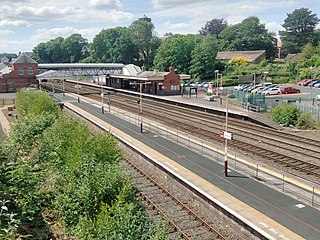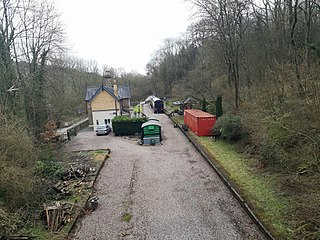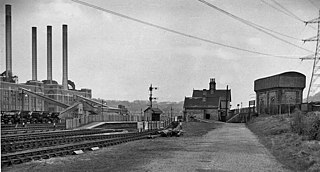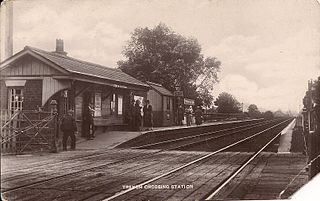
Telford is a town in the Telford and Wrekin borough in Shropshire, England. The wider borough covers the town, its suburbs and surrounding towns and villages. The town is close to the county's eastern boundary, and near the River Severn. The notable hill near the town called The Wrekin is part of the Shropshire Hills, an Area of Outstanding Natural Beauty. To the south of the town is the Ironbridge Gorge, a UNESCO World Heritage Site. Places around the Ironbridge Gorge area, which were developed into the town itself, are internationally recognised as being "The Birthplace of Industry" being to a large extent constructed during the Industrial Revolution on the Shropshire Coalfield. The town is the main adminstrative centre for Telford and Wrekin Council.

Wellington is a market town and a civil parish in the borough of Telford and Wrekin, Shropshire, England. It is situated 3 miles (4.8 km) north-west of Telford town centre and 12 miles (19 km) east of Shrewsbury; the summit of The Wrekin lies 3 miles south-west of the town. The population of the town was 25,554 in 2011.

The English county of Shropshire has a fairly large railway network, with 19 National Rail stations on various national lines; there are also a small number of heritage and freight lines, including the famous heritage Severn Valley Railway running along its eastern border with Worcestershire.

The Telford Steam Railway (TSR) is a heritage railway located at Horsehay, Telford in Shropshire, England, formed in 1976.

The Wolverhampton–Shrewsbury line is the railway line from Wolverhampton to Shrewsbury via Wellington; it was originally built by the Shrewsbury and Birmingham Railway. The line is double track throughout, with rarely used relief sidings at Cosford and four tracks through Wellington station.

The Shrewsbury and Birmingham Railway was authorised in 1846. It agreed to joint construction with others of the costly Wolverhampton to Birmingham section, the so-called Stour Valley Line. This work was dominated by the hostile London and North Western Railway, which used underhand and coercive tactics. The section between Shrewsbury and Wellington was also built jointly, in this case with the Shropshire Union Railway.

Wellington railway station serves the town of Wellington, Shropshire, England. It is situated on the former Great Western Railway's London Paddington to Birkenhead via Birmingham Snow Hill line. Trains are operated by West Midlands Railway, and Transport for Wales.

Oakengates railway station serves the town of Oakengates, Telford and Wrekin, Shropshire, England. It has two platforms.

The GWR Coalport railway station, active 1862–1963, was originally built as a single through platform railway station on the Severn Valley Line serving the village of Coalport in Shropshire, England. By January 1896 an additional platform had been added, thus permitting up and down trains to pass along, with a third platform face behind the up platform to form an east-facing bay. By this time, the goods sidings to the east of the station had been expanded.

Buildwas railway station was an isolated junction railway station on the Wellington to Craven Arms Railway and Severn Valley Railway. Opened on 1 February 1862. Although the station served both the Severn Valley Railway and Wellington to Craven Arms Railway, it was an interchange station in open countryside with no passenger access except by rail.

Newport (Shropshire) station was a railway station serving Newport in Shropshire. that was situated on the Stafford to Shrewsbury Line via Wellington.
The Stafford–Shrewsbury line is a former railway line in England, which ran between Stafford in Staffordshire and Shrewsbury in Shropshire, via Newport and Wellington, from 1849 to 1966. The Shropshire Union Railways and Canal Company (SUR&CC) constructed and ran one of the few railways in England ever built by a canal company. The line served Newport and Wellington stations. The SUR&CC were solely responsible for the section from Stafford to Wellington; but the building and operation of the 10.5 mile (17 km)-long Shrewsbury-to-Wellington section was shared with the Shrewsbury and Birmingham Railway.

The Coalport branch line was a standard gauge London and North Western Railway branch line in Shropshire, England, which ran between Hadley Junction near Oakengates on the Stafford to Shrewsbury line and a terminus at Coalport East railway station on the north bank of the River Severn at Coalport.

Donnington railway station was a railway station in Shropshire, England. It was built by the Shropshire Union Railway who opened it in 1849, Passenger service ceased in September 1964, and freight service ceased on 4 October 1965.
Upton Magna railway station was a station in Upton Magna, Shropshire, England.
Walcot railway station was a station in Walcot, Shropshire, England. The station was sited on the Wolverhampton to Shrewsbury line west of Wellington (Shropshire) and opened on 1 June 1849. It closed on 7 September 1964, along with the other intermediate stations on this stretch of line. The station was demolished after closure and no trace now remains.

Trench Crossing railway station was a station in Trench, Shropshire, England. The station was opened in 1854 and closed in 1964.

Lightmoor Platform railway station was a station to the east of Coalbrookdale, Shropshire, England. The station was opened in 1907 and closed in 1962. The station was situated on the Madeley Junction to Buildwas Line to the west of Lightmoor Junction.

Gnosall railway station was a station in Gnosall, Staffordshire, England. The station was opened in June 1849 and closed on 7 September 1964.

Leegomery is a village in the Telford and Wrekin borough in Shropshire, England. It forms part of the Hadley and Leegomery civil parish alongside Hadley, Apley Castle, Hadley Castle, Hadley Manor, Hoo and Horton.

















